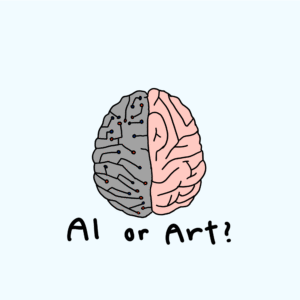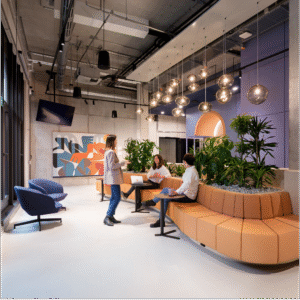16-year-old explores the negative effects of AI on art

'AI doesn’t have a heart or brain, making it impossible to replicate human emotional depth.'
Illustration: Jennifer Yung-Coak
Article link copied.
August 10, 2025 opinion
Art should be kept away from AI. Period

As someone who always turned to drawing, painting and designing to explore both the world and myself, I find it hard to imagine art without a soul.
In the 21st century, where Artificial Intelligence (AI) can generate vibrant, captivating artwork within milliseconds, the boundaries of creativity are redefined every day.
While the AI’s ability to create art is impressive and attractive, it poses a deeper question: should the future of art be left in the hands of emotionless machines? Despite its efficiency and simplicity, I believe that AI strips art of what makes it valuable and should not be used in the creation of art.
Harbingers’ Weekly Brief
Art is more than the shapes and colours on the canvas. It is a form of human expression, allowing artists to reflect and explore. For many artists, including myself, the canvas is an outlet that allows me to express feelings that words can’t capture. When I paint, I like to use colours or textures that reflect my feelings and thoughts. For others, viewing or buying art offers a sense of comfort and empathy.
It is no secret that AI doesn’t have a heart or brain, making it impossible to replicate human emotional depth. There is no story or emotion behind the tiny pixels glaring through our screens, leaving viewers emotionally empty.
When candidates were shown one AI-generated art and one human-made art, a research from 2023 found that “people have more positive emotions when looking at the human paintings”, and ranked human paintings higher in “self-reflection, attraction, nostalgia and amusement”. It is a great example that true art demands more than visual appeals – it requires humanity.
In addition, as more teenagers start feeling lonely and depressed, the need for human connection is more important than ever. Art is a common outlet for many teenagers. If we replace this emotional outlet with AI, we risk removing the healing, relatable core of art that many depend on.
AI can’t think outside the box
Creativity drives art. It allows artists to challenge the limits of traditional methods, creating innovative and unique techniques to create engaging and fresh insights. While drawing, creativity pushes me to improve and explore, making my art uniquely me.
But unlike humans, AI engines can’t think outside the box. AI engines can only remix ideas from pre-existing data and algorithms.
In 2024, American researchers Eric Zhou and Dokyun “DK” Lee studied the correlation between AI art and human creativity. They found that while AI creates more room for creativity, the ideas of artists who used AI progressively became more generic. AI will kill the trailblazing spirit of creativity that has driven artistic expression for thousands of years.
Beyond creativity, AI-generated art raises a series of ethical concerns, specifically authorship and ownership. Since AI isn’t able to generate new ideas, it is trained to borrow or steal ideas from artists across databases.
In 2023, a group of American artists, Sarah Andersen, Kelly McKernan, and Karla Ortiz, sued Stability AI for violating artist rights. They claim that Stability AI gained commercial profit by selling their work without their consent, exploiting their work and effort.
If art becomes machines without ethical boundaries, it risks devaluing the time, effort and passion that artists pour into their creation. We can all agree imitation without ethical consent is not creativity.
Some might argue that AI opens up art to people who lack strong artistic abilities, allowing them to create “better” or “perfect” looking art.
But art is not supposed to be perfect – there is no universal scale by which art is judged. Everyone has their own story and style, and embracing individuality is important. Relying on AI to create repetitive art overlooks the creative process that is essential to art entirely.
AI-generated art may be finding its place in today’s world, but it will never find itself in the heart of what makes art meaningful. To protect the future of art from AI, I think we should keep art in our hands, otherwise, is it still art or just digital codes?
Written by:

Contributor
Hong Kong
Born in 2009 in Hong Kong, Jennifer studies in New Hampshire, US. She is interested in design, business, and economics, and plans to study at an American university. For Harbinger’ Magazine, she writes about architecture, international relations and human rights.
In her free time, Jennifer enjoys travelling, drawing, and playing sports. She also participates in volunteer programs with children.
Jennifer speaks English, Cantonese, and Chinese.
🌍 Join the World's Youngest Newsroom—Create a Free Account
Sign up to save your favourite articles, get personalised recommendations, and stay informed about stories that Gen Z worldwide actually care about. Plus, subscribe to our newsletter for the latest stories delivered straight to your inbox. 📲
© 2025 The Oxford School for the Future of Journalism



